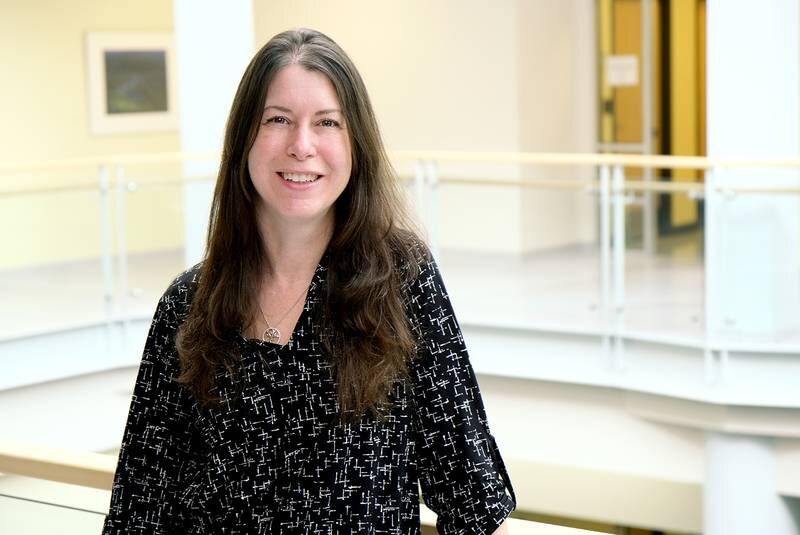Saint Mary’s University psychology department professor Dr. Nicole Conrad.
A researcher at Saint Mary’s University in Halifax is studying a fundamental skill in education: learning to read.
Dr. Nicole Conrad, a cognitive psychologist and professor in the Psychology department, has received a prestigious federal research grant to pursue how spelling facilitates the development of reading skills in elementary school children.
A $92,000 Insight Grant from the federal Social Sciences and Humanities Research Council (SSHRC) agency will allow her to pursue a research project titled “Spelling matters, too! The role of spelling practice on the development of reading skill.”
Conrad’s project involves research in elementary schools focusing on how memory is involved in the process of reading. This research will continue virtually with families around Nova Scotia, with COVID-19 safety precautions in mind.
“I am looking at how spelling and reading develop, interact, and help or facilitate each other,” says Conrad. “This is the first of a longitudinal study, tracking their relation over a period.”
“When I talk about what kids are learning when spelling, it is about how they are putting that information into memory, storing it, and accessing it at a later time when they are reading.”
Social Sciences and Humanities Research Council (SSHRC) awarded Dr. Nicole Conrad of Saint Mary’s University a $92,000 Insight Grant to continue her research that’s essential to the betterment of instructional practices for Canadian teachers..
Conrad’s undergraduate students play an integral role in this research, administering reading and spelling tests to elementary school children—while practicing vital research techniques themselves.
In one study the researchers first teach words with specific orthographic or letter patterns to early readers. After a period of time, they retest the children to study the effect of learning the patterns of letters — ick, ing, for example — on their word reading and reading comprehension.
“Decoding words is critical,” says Conrad. “Our written language represents our oral language, so at an early age children must learn how reading and spelling map together.”
She notes English is one of the most challenging languages to master.
“It is very inconsistent in terms of the mappings between the letters and sounds. We have letters that make more than one sound, and we have sounds represented by more than one letter. We want to determine how spelling might aid with learning these mappings,” she says. “I usually start working with kids in Grade 2, and by that point there are kids who understand that they are not strong readers. When they struggle to read it harms their self-confidence, which is heartbreaking to see.”
SSHRC is a federal research funding agency that promotes and supports post-secondary based research and training in social sciences and the humanities. The Canadian agency recognized Conrad as an established national leader in research devoted to understanding reading.
Conrad’s research looks at the underlying mechanisms of how children learn to read, with an ultimate goal of creating best practices for Canadian teachers through greater understanding of how children learn language.
“There is vast variability in teaching our kids to read,” says Conrad. “A public inquiry by the Ontario Human Rights Commission is currently underway, examining whether teaching practices in Ontario are based on what science says works.”
Along with her students, Conrad eagerly awaits the results of this public inquiry, expected this spring.
“My students and I will then evaluate the implications of these results on instructional methods used in Nova Scotia and incorporate these findings into our research.
Going beyond the laboratory and getting first-hand research experience in schools is exciting and empowering — bringing everything into perspective.
“I love being able to hire students through multiple programs offered at Saint Mary’s, allowing them to mix their course work with experiential learning and original research,” says Conrad.
Psychology graduates studying under Conrad have pursued their dream careers in clinical psychology, education, school psychology, and speech-language pathology, to name a few.
Conrad says her inspiration to be a professor stems from a love of teaching students to be productive, well-respected citizens. But the “a-ha!” moment for this passion came later in life.
Dr. Nicole Conrad’s son is the inspiration for the current research on the spelling-reading connection.
“My young son makes my research come alive. It is magical when I watch him read. He puts into perspective everything I learned and shows me what I do is real,” she says. “I always wanted a career that made me excited to get up in the morning, and I have met those expectations at Saint Mary’s.”
This story first appeared in The Chronicle-Herald.



